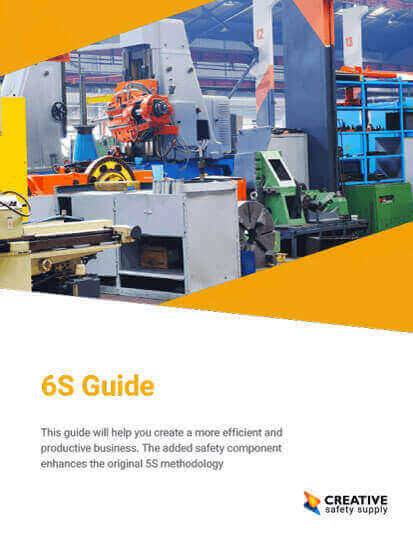
The realm of workplace optimization and employee well-being is a tapestry woven with the threads of methodologies like 6S safety. But how exactly does 6S safety work its magic? In this comprehensive exploration, we unravel the intricate mechanisms that underpin the fusion of 6S principles and safety practices, while providing some examples. By delving into the inner workings of 6S safety, organizations can unlock the key to orchestrating environments where operational excellence and employee safety coexist harmoniously. In this blog post, we will take a list at the core dynamics of 6S and how they work together to contribute to safety.
The Core Dynamics of 6S Safety
At its core, 6S safety operates as a strategic framework that fuses Lean principles with safety practices, creating an environment where safety and efficiency are not opposing forces but complementary allies.
Dynamic 1: Sort and Safety
The journey begins with the "Sort" dynamic. This step involves scrutinizing the workspace and eliminating non-essential items. Beyond mere tidying, this process enhances safety by de-cluttering the environment. Reduced clutter translates to fewer tripping hazards, clearer emergency routes, and an overall safer space for employees to navigate.
Dynamic 2: Set in Order and Safety
The "Set in Order" dynamic seamlessly aligns with safety priorities. By arranging tools and materials in logical and accessible patterns, organizations ensure that employees can retrieve what they need without resorting to risky movements. This dynamic diminishes the chances of reaching or bending awkwardly, reducing the risk of accidents.
Dynamic 3: Shine and Safety
The "Shine" dynamic transcends cleanliness. A clean workspace is a safer workspace. Regular cleaning prevents the buildup of dirt and debris that could lead to slips or falls. Moreover, a clean environment reflects a commitment to employee well-being, fostering a sense of pride and engagement.
Dynamic 4: Standardize and Safety
"Standardize" sets the stage for predictability and, by extension, safety. When processes and procedures are uniform, employees can anticipate their tasks and environments. This predictability reduces the potential for unexpected situations that could compromise safety.
Dynamic 5: Sustain and Safety
"Sustain" is not just about maintaining standards; it's about fostering a culture where safety is a living value. When safety becomes second nature, employees become attuned to potential hazards and take proactive steps to prevent accidents. This cultural shift amplifies safety beyond rules and regulations.
Dynamic 6: Safety and Safety
The culminating dynamic is, of course, "Safety." Embedded within every step of 6S, this principle transcends a single dynamic and becomes the overarching mission. It encompasses hazard identification, risk mitigation, provision of personal protective equipment (PPE), and a commitment to safeguarding employee well-being.
The Synergy of Safety and Efficiency
The beauty of 6S lies in its ability to include safety and efficiency, two objectives that might initially appear to be at odds. By using 6S for safety, organizations create an environment where employees can focus on tasks without worrying about unnecessary risks, and do it all in the most productive way. This absence of worry translates to increased focus, productivity, and innovation, ultimately enhancing efficiency.
Leadership's Role in Fostering 6S Safety
Leadership holds a crucial role in the mechanics of 6S safety. Their visible commitment to safety sets the tone for the entire organization. By allocating resources, providing training, and actively participating in safety initiatives, leaders create a culture where safety is not just a priority but a way of life.
The Impact of 6S Safety
The impact of 6S safety extends beyond mere compliance. Organizations that wholeheartedly embrace 6S safety experience a monumental shift in their operations:
- Reduced Incidents: The proactive identification and mitigation of hazards lead to a significant reduction in workplace accidents and injuries.
- Heightened Morale: A safe environment empowers employees, boosting their morale, job satisfaction, and engagement.
- Streamlined Operations: The principles of 6S eliminate inefficiencies and streamline processes, reducing delays caused by accidents or unsafe conditions.
- Cost Savings: The reduction in accidents, coupled with enhanced efficiency, translates to cost savings in terms of medical expenses, legal fees, and downtime.
The symphony of 6S safety orchestrates a workplace where harmony reigns between safety and efficiency. The dynamics of Sort, Set in Order, Shine, Standardize, Sustain, and Safety interweave to create an environment where employees thrive, operations flourish, and accidents are minimized. The mechanics of 6S safety unveil a roadmap for organizations to navigate the complex terrain of modern workplaces, embracing safety as a linchpin of success and operational excellence.
Similar Questions
- What is 6S Safety?
- What are the Rules of 6S Safety?
- How Do I Use 6S for Safety?
- How Can 6S Improve Workplace Safety and Reduce Incidents?
- What is the Definition of 6S?
- What are Some Examples of 6S?
- Can You Use a Checklist for 6S?
- How Do I Set Up a 6S Safety Program?
- Why should you implement 6S in your workplace?

